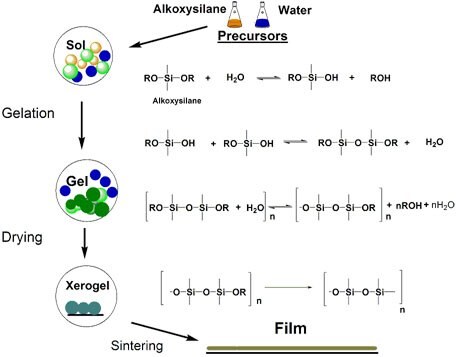Deposition Grade Silanes for Sol-Gel Processes
Sol-gel processing is beneficial in the formation of ceramic and glass films for a number of reasons.1-4 It is a simple process that does not require exotic materials, catalysts or expensive deposition equipment. Sol-gel reactions do not employ extreme reaction conditions and the properties of the materials prepared using sol-gel approaches are easy to modify by utilizing an organically modified precursors.2,3
Deposition Grade Silanes comprise alkoxysilanes and their predecessors chlorosilanes typically used in a Sol-Gel process. Transformations of alkoxysilanes during the processing proceed through a series of subsiquent hydrolysis, condensation and thermal treatment steps briefly outlined in Figure 1.

Figure 1.Transformations of alkoxysilanes during the Sol-Gel process through a series of subsequent hydrolysis, condensation and thermal treatment steps.
Applications of Deposition Grade Silanes include but are not limited to
- film coatings on glass and other appropriate surfaces1,4
- reinforcement of polymeric structures1, such as polyesters,16 Nafion®,17 Surlyn®
- hermetic barriers for electronics and electrochemical devices5
- and others applications where Si-O-based chain assemblies are desirable.3,4
Extensive analytical data available for Deposition Grade Silanes allow for a better understanding of chemical composition and properties of the materials created using these precursors as compared to those prepared form conventional silanes available commercially.
Purity of our Deposition Grade Silanes exceed 98%. They are fully characterized by chemical analysis and nuclear magnetic resonance (NMR). The impurities present in these materials are detected using a gas-chromatography (GC) and/or a GC-MS technique and reported on the Certificate of Analysis (CA). In addition, trace metals impurities are also reported on the CA.
Trademarks
Nafion is a registered trademark of The Chemours Company FC, LLC
Surlyn is a registered trademark of E.I. du Pont de Nemours and Company
References
如要继续阅读,请登录或创建帐户。
暂无帐户?